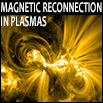Speaker
Dr
Keizo Fujimoto
(National Astronomical Observatory of Japan)
Description
Understanding the wave properties in magnetic reconnection is very
important in
collisionless plasmas. The waves can transport the momentum and
energy between
the different species, resulting in the anomalous magnetic dissipation,
particle
heating, and the formation of non-thermal particles.
Observations in the Earth’s magnetosphere and laboratory
experiment have
shown that the wave activities are significantly enhanced in a broad
range of
frequency around the separatrices and the x-line. The waves are
recognized as
lower hybrid waves, Langmuir waves, electrostatic solitary waves
(ESWs), and
whistler waves. However, it is difficult from observation alone to
identify the
generation mechanisms of the waves and their roles in magnetic
reconnection.
We have performed large-scale particle-in-cell (PIC) simulations with
adaptive
mesh refinement (AMR) in 2D and 3D systems. Our simulations have
shown that the
waves in the separatrix regions can be explained by beam-driven
instabilities while
shear-driven modes are dominant around the x-line. In both the
regions, the
electrons are strongly heated due to the waves. In particular, the
waves around the
x-line are responsible for the magnetic dissipation which drives a
collisionless
reconnection.
In this presentation, we will show recent results of large-scale PIC
simulations of
anti-parallel collisionless reconnection, and clarify the generation
mechanism of the
waves and their roles in reconnection.
Author
Dr
Keizo Fujimoto
(National Astronomical Observatory of Japan)

